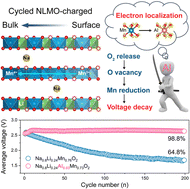Unraveling and suppressing the voltage decay of high-capacity cathode materials for sodium-ion batteries†
Abstract
Oxygen-redox-active (ORA) layered oxide cathodes for sodium-ion batteries have received considerable attention due to their ultrahigh capacity. However, the voltage decay during electrochemical cycling in such materials is still elusive and unsolved, which seriously limits their practical implementation. Herein, we unveil the intrinsic origin of voltage decay in sodium-based ORA cathodes by coupling spatially local electron energy loss spectroscopy with bulk-sensitive X-ray absorption spectroscopy. It is demonstrated that the steric heterogeneity of Mn redox derived from the surface formation of oxygen vacancies is responsible for the voltage deterioration upon cycling. Moreover, we propose an ORA cathode (Na0.8Li0.24Al0.03Mn0.73O2) with negligible voltage decay. Its oxygen redox reversibility is significantly strengthened because the strong Al–O bonds weaken the covalency of Mn–O bonds to promote the electron localization on oxygen. These findings suggest a new insight into the electronic structure design of high-energy-density cathode materials for advanced rechargeable batteries.



 Please wait while we load your content...
Please wait while we load your content...